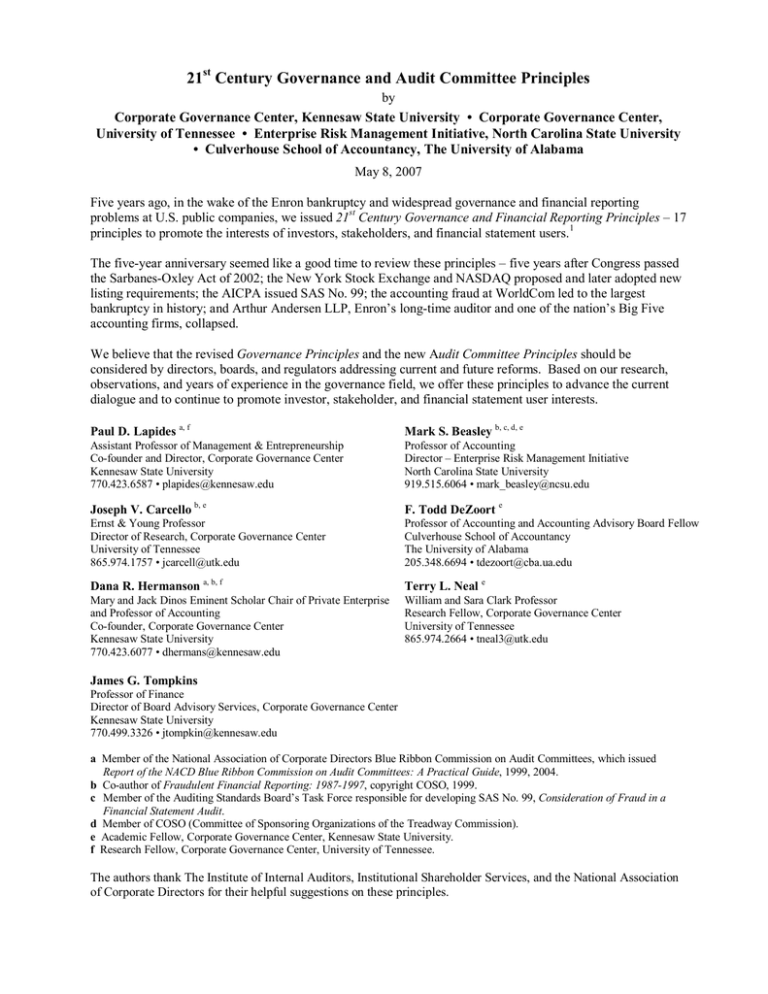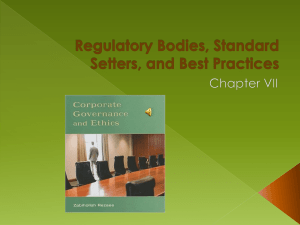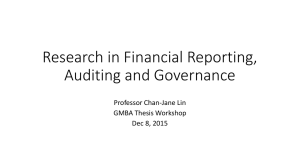21 Century Governance and Audit Committee Principles
advertisement

21 st Century Governance and Audit Committee Principles by Corporate Governance Center, Kennesaw State University • Corporate Governance Center, University of Tennessee • Enterprise Risk Management Initiative, North Carolina State University • Culverhouse School of Accountancy, The University of Alabama May 8, 2007 Five years ago, in the wake of the Enron bankruptcy and widespread governance and financial reporting problems at U.S. public companies, we issued 21 st Century Governance and Financial Reporting Principles – 17 principles to promote the interests of investors, stakeholders, and financial statement users. 1 The five­year anniversary seemed like a good time to review these principles – five years after Congress passed the Sarbanes­Oxley Act of 2002; the New York Stock Exchange and NASDAQ proposed and later adopted new listing requirements; the AICPA issued SAS No. 99; the accounting fraud at WorldCom led to the largest bankruptcy in history; and Arthur Andersen LLP, Enron’s long­time auditor and one of the nation’s Big Five accounting firms, collapsed. We believe that the revised Governance Principles and the new Audit Committee Principles should be considered by directors, boards, and regulators addressing current and future reforms. Based on our research, observations, and years of experience in the governance field, we offer these principles to advance the current dialogue and to continue to promote investor, stakeholder, and financial statement user interests. Paul D. Lapides a, f Mark S. Beasley b, c, d, e Assistant Professor of Management & Entrepreneurship Co­founder and Director, Corporate Governance Center Kennesaw State University 770.423.6587 • plapides@kennesaw.edu Professor of Accounting Director – Enterprise Risk Management Initiative North Carolina State University 919.515.6064 • mark_beasley@ncsu.edu Joseph V. Carcello b, e F. Todd DeZoort e Ernst & Young Professor Director of Research, Corporate Governance Center University of Tennessee 865.974.1757 • jcarcell@utk.edu Professor of Accounting and Accounting Advisory Board Fellow Culverhouse School of Accountancy The University of Alabama 205.348.6694 • tdezoort@cba.ua.edu Dana R. Hermanson a, b, f Terry L. Neal e Mary and Jack Dinos Eminent Scholar Chair of Private Enterprise and Professor of Accounting Co­founder, Corporate Governance Center Kennesaw State University 770.423.6077 • dhermans@kennesaw.edu William and Sara Clark Professor Research Fellow, Corporate Governance Center University of Tennessee 865.974.2664 • tneal3@utk.edu James G. Tompkins Professor of Finance Director of Board Advisory Services, Corporate Governance Center Kennesaw State University 770.499.3326 • jtompkin@kennesaw.edu a Member of the National Association of Corporate Directors Blue Ribbon Commission on Audit Committees, which issued Report of the NACD Blue Ribbon Commission on Audit Committees: A Practical Guide, 1999, 2004. b Co­author of Fraudulent Financial Reporting: 1987­1997, copyright COSO, 1999. c Member of the Auditing Standards Board’s Task Force responsible for developing SAS No. 99, Consideration of Fraud in a Financial Statement Audit. d Member of COSO (Committee of Sponsoring Organizations of the Treadway Commission). e Academic Fellow, Corporate Governance Center, Kennesaw State University. f Research Fellow, Corporate Governance Center, University of Tennessee. The authors thank The Institute of Internal Auditors, Institutional Shareholder Services, and the National Association of Corporate Directors for their helpful suggestions on these principles. Founded in 1995, Kennesaw State University’s Corporate Governance Center is a leading provider of corporate governance information to directors, researchers, professors, advisors, and other interested parties (http://www.kennesaw.edu/cgc). Composed of over 20 professors from several universities, the Center promotes effective corporate governance for public, private, and nonprofit enterprises, with particular emphasis on audit committees and entrepreneurial companies. The Corporate Governance Center (www.corpgovcenter.org) at the University of Tennessee will be among the national leaders in conducting and disseminating research on aspects of corporate governance. The Center’s primary emphasis will be on those aspects of corporate governance with a significant public policy focus – the work of the audit, compensation, and nominating committees. A joint initiative between the College of Business Administration and College of Law, the Center involves faculty from accounting, economics, finance, law, and management and includes fellows from other universities. The ERM Initiative at North Carolina State University provides national and international thought leadership on enterprise risk management (ERM) and on the implementation of ERM in strategy development and corporate governance. The ERM Initiative is pioneering the development of this emergent discipline through outreach to business professionals with ongoing ERM Roundtable Series, through research to advance knowledge and understanding of ERM issues, and through undergraduate and graduate business education for the next generation of business executives. The ERM Initiative’s web site (www.erm.ncsu.edu) contains summaries and links to numerous ERM Resources. The mission of the Culverhouse School of Accountancy (www.cba.ua.edu/accounting) at The University of Alabama is to maintain high quality undergraduate and graduate programs that attract top students and prepare them for careers in business and to foster the understanding and practice of accounting through research, professional service, and outreach activities. The undergraduate accounting program at the Culverhouse School of Accountancy is ranked 15th nationally in the latest rankings released by Public Accounting Report (October 2006). 2 21 st Century Governance Principles for U.S. Public Companies 1. Board Purpose – The board of directors should understand that its purpose is to promote and protect the interests of the corporation’s stockholders, while considering the interests of other external and internal stakeholders (e.g., creditors, employees, etc.). 2. Board Responsibilities – The board’s major areas of responsibility should be monitoring the CEO and other senior executives; overseeing the corporation’s strategy and processes for managing the enterprise, including succession planning; and monitoring the corporation’s risks and internal controls, including the ethical tone. Directors should employ healthy skepticism in meeting these responsibilities. 3. Interaction – Sound governance requires effective interaction among the board, management, the external auditor, the internal auditor, and legal counsel. 4. Independence – An “independent” director has no current or prior professional or personal ties to the corporation or its management other than service as a director. Independent directors must be able and willing to be objective in their judgments. The vast majority of the directors should be independent in both fact and appearance. 5. Expertise and Integrity – Directors should possess relevant business, industry, company, and governance expertise. The directors should reflect a mix of backgrounds and perspectives and have unblemished records of integrity. All directors should receive detailed orientation and continuing education to assure they achieve and maintain the necessary level of expertise. 6. Leadership – The roles of Board Chair and CEO should be separate. If the roles are not separate, then the independent directors should appoint an independent lead director. The lead director and committee chairs should provide leadership for agenda setting, meetings, and executive sessions. 7. Committees – The audit, compensation, and governance committees of the board should have charters, authorized by the board, which outline how each will be organized, their duties and responsibilities, and how they report to the board. Each of these committees should be composed of independent directors only, and each committee should have access to independent outside advisors who report directly to the committee. 8. Meetings and Information – The board and its committees should meet frequently for extended periods of time and should have unrestricted access to the information and personnel they need to perform their duties. The independent directors and each of the committees should meet in executive session on a regular basis. 9. Internal Audit – All public companies should maintain an effective, full­time internal audit function that reports directly to the audit committee. Companies also should consider providing an internal audit report to external stakeholders to describe the internal audit function (e.g., composition, responsibilities, activities). 10. Compensation – The compensation committee and full board should carefully consider the compensation amount and mix (e.g., short­term vs. long­term, cash vs. equity) for executives and directors. The compensation committee should evaluate the incentives and risks associated with a heavy emphasis on short­term performance­based incentive compensation for executives and directors. 11. Disclosure – Proxy statements and other communications (required filings and press releases) should reflect board and corporate activities and transactions in a transparent and timely manner (e.g., financial performance, mergers and acquisitions, executive compensation, director compensation, insider trades, related­party transactions). Companies with anti­takeover provisions should disclose why such provisions are in the best interests of their shareholders. 12. Proxy Access – The board should have a process for shareholders to nominate director candidates, including access to the proxy statement for long­term shareholders with significant ownership stakes. 13. Evaluation – The board should have procedures in place to evaluate on an annual basis the CEO, the board committees, the board as a whole, and individual directors. The evaluation process should be a catalyst for change in the best interests of the shareholders. Lapides, P.D., M.S. Beasley, J.V. Carcello, F.T. DeZoort, D.R. Hermanson, T.L. Neal, and J.G. Tompkins. May 8, 2007. 3 21 st Century Audit Committee Principles for U.S. Public Companies 1. Committee Purpose – The purpose of the audit committee is to oversee all aspects of the financial reporting process, including preparation and filing of financial statements, internal control over financial reporting, and related risks. 2. Committee Responsibilities – The audit committee’s major areas of responsibility include: (1) oversight of the internal control system, (2) oversight of the internal audit function and external auditor, (3) review of financial filings, and (4) establishment and oversight of a “whistleblower” process. 3. Interaction – Audit committee effectiveness requires ongoing, timely, and substantive interaction among the board, management, the external auditor, the internal auditor, and legal counsel. 4. Independence – The audit committee should be composed of independent directors only, and these directors should be chosen by an independent nominating committee. The CEO’s role in selecting new directors, especially those who are targeted for audit committee service, should be limited. 5. Expertise and Integrity – The audit committee should have at least one financial expert, and all other members should have a high level of financial literacy. The financial expert should have a background in accounting, and there should be increased proxy disclosure as to the nature and timing of this accounting background. The committee members should reflect a mix of backgrounds and perspectives, and each member should be familiar with the company’s risks and controls and capable of inquisitive and independent judgment. All members should receive detailed orientation and continuing education on financial accounting and reporting issues to assure they achieve and maintain the necessary level of expertise. 6. Philosophy and Culture – The audit committee should clearly set expectations that financial statements and supporting disclosures reflect economic substance and that they be prepared in a manner that is informative and transparent. A legalistic view of accounting and auditing (e.g., “can we get away with recording it this way?”) is not appropriate. Management integrity and a strong control environment are critical to reliable financial reporting. 7. Internal Control – The audit committee is responsible for ensuring that management designs and implements sound internal control, which is essential for reliable financial reporting for any organization. Section 404 of the Sarbanes­Oxley Act should apply to all public companies, and the primary focus of reporting on internal control should be effectiveness. 8. Risk Assessment – The audit committee should lead the board’s assessment of enterprise risk, including the risk of management override of internal control. The board also should discuss the audit committee’s fraud risk assessments and the fraud risk assessments developed by internal and external auditors. 9. Meetings and Information – The audit committee members should meet frequently for extended periods of time and should have unrestricted access to the information and personnel they need to perform their duties. Face­to­face meetings should occur at least quarterly, and executive sessions should be held at each of these meetings. Additionally, the committee should meet in separate executive sessions with management, the external auditor, the internal auditor, legal counsel, and other advisors. 10. External Auditor – The audit committee should hire, evaluate, fire (if appropriate), and determine the fee of the external auditor with only minimal input from senior management. The committee should review the proposed audit scope and approach, as well as the external auditor’s independence. Additionally, the committee should seek audit firms whose personnel are selected, evaluated, compensated, and promoted primarily on the basis of technical competence, not on their ability to generate new business. 11. Internal Audit – The chief (internal) audit executive should have direct reporting access to the audit committee, and the committee should oversee the activities and budget of the internal audit function. 4 12. Oversight of “Whistleblower” Procedures – Whistleblower allegations should be initially screened by internal audit or an external whistleblower system provider and reported directly to the audit committee. Access to the whistleblower process should be extended to outside parties (e.g., customers, suppliers, etc.). 13. Compensation and Stock Ownership – The board should consider any risks of audit committee member stock/stock option holdings and should set compensation at a level that is appropriate for the expanded duties and risks these members face. 14. Service and Term Limits – The board should limit the number of other audit committees on which its audit committee members can sit to no more than one other public company if the member holds a full­time position (three others for members who are retired). The board should consider limiting the number of years an individual can serve on the audit committee to ensure adequate rotation of its members. 15. Disclosure – In addition to disclosure of the audit committee responsibilities in the charter, the annual proxy statement should contain an audit committee report on actual activities performed. The audit committee should disclose the processes it uses in discharging its responsibilities, including: (1) the length of its meetings; (2) meeting participants; (3) use of executive sessions; (4) how the committee selects, compensates, and oversees the external auditor; (5) how the committee oversees the internal audit function; (6) the committee’s role in overseeing internal control; (7) committee activities performed to assess the risk of fraudulent financial reporting, especially via management override of internal control; and (8) activities performed by the committee to review financial filings before their release to the public. Lapides, P.D., M.S. Beasley, J.V. Carcello, F.T. DeZoort, D.R. Hermanson, T.L. Neal, and J.G. Tompkins. May 8, 2007. 1 The 21 st Century Governance and Financial Reporting Principles, issued on March 26, 2002, were presented to the New York Stock Exchange (NYSE) as part of a presentation made by the Institute of Internal Auditors (IIA) in April 2002. The IIA also distributed the principles to the U.S. Securities and Exchange Commission (SEC), American Stock Exchange, National Association of Securities Directors (NASD), National Association of Corporate Directors (NACD), Financial Executives International (FEI), all members of Congress and the White House staff assigned to address governance and financial matters. The 2002 principles have been widely cited and republished in numerous text books. 5


